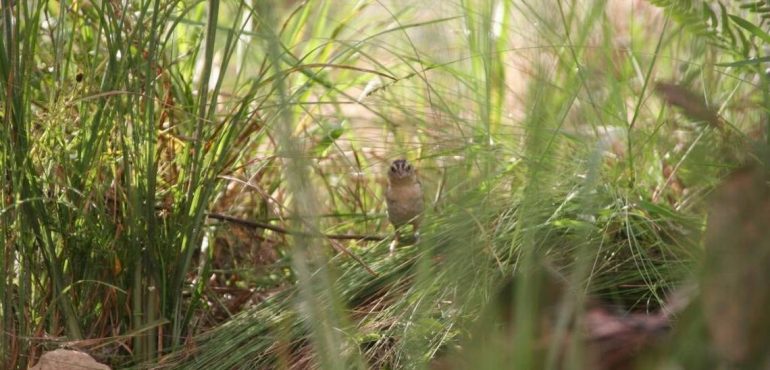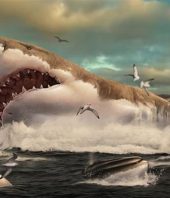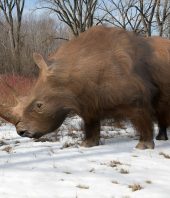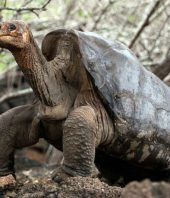The grasshopper sparrow, a tiny Florida prairie bird perched on the verge of extinction for the last decade, may have encountered a final, unconquerable foe: an invasive new disease quickly killing off its young.
The disease has spread so rapidly that wildlife managers now fear another endangered sparrow, the Cape Sable seaside sparrow in the Everglades, could also be at risk if numbers fall any lower.
“Extinction is a real possibility,” for the grasshopper sparrow, said Larry Williams, the U.S. Fish and Wildlife Service’s Florida supervisor for ecological services. “We are very anxious to know what these diseases are, and how they’re operating.”
Another threat is also at play: money. The Service has so far spent $1 million on conservation efforts, including a captive breeding program, aided by private donations. Williams said the agency has requested another $150,000 to $200,000 for the coming year, but “budget uncertainties” remain. And with nesting season starting in May, time may be running out.
“2018 is really the do or die year for the grasshopper sparrow,” said Paul Reillo, president of the Rare Species Conservatory Foundation in Palm Beach County, where the first captive sparrow was bred two years ago and which has set up a matching grant fund drive with Florida International University’s Tropical Conservation Institute. “The facilities need to be built now so we can apply our best effort this season to ensure the birds are given their very best chance.”
The Fish and Wildlife Foundation of Florida has also set up an emergency fund, which Williams said has so far raised $12,000.
With the number of the wild birds expected to total less than 40 this year, the grasshopper sparrow, which lives only in shrinking swathes of prairie in Central Florida, could well become another sad chapter in the state’s foundering effort to save its prairie sparrows.
Eight species of prairie or seaside sparrows once darted across Florida’s rolling marshes and dry prairies, shy golf-ball sized ground dwellers perfectly feathered to disappear and nest in the tall grasses. Being so earthbound made them vulnerable to predators, like snakes and invasive fire ants, flooding during heavy rains, and parasites in the soil they foraged for bugs. But their biggest threat turned out to be development, with nearly all their habitat paved over or altered for flood control.
Two birds, the Smyrna and dusky seaside sparrow, vanished by 1987 as their habitat disappeared. Two others are in decline. And two, the grasshopper and Cape Sable, now face what wildlife managers call the extinction vortex — an unstoppable downward spiral reached when populations drop to such low numbers that threats like disease and shrinking habitat become mutually reinforcing.
“That tells us we can’t let populations get below certain thresholds,” Williams said. “So we’re watching for these parallels.”
The captive breeding program was supposed to solve that part of the puzzle. Launched in 2013 as a joint effort between the Service and several conservation programs, biologists captured a handful of birds in an attempt to hatch and rear their fragile thumb-sized chicks. After three years struggling to find the perfect balance of incubating and feeding, they succeeded first at the Palm Beach County facility, and then at North Florida’s White Oak plantation.
But about six months ago, young captive sparrows began mysteriously dying from an intestinal parasite, said Reillo, who is co-director of FIU’s conservation institute.
Prairie sparrows are particularly susceptible to the parasites, which live in the soil where the birds hunt grasshoppers, spiders and other bugs. Intestinal parasites are also common in captive breeding programs. But Reillo is certain the breeding facilities were clean and believes the disease was carried in by wild birds brought to expand the captive flock, which now numbers about 30, suggesting the parasite is already circulating in the wild.
Other biologists, however, aren’t ready to conclude that the parasite is killing wild birds.
Andrew Schumann, White Oak’s aviation collection manager, said captivity could be worsening the illness because the birds are concentrated in a small space, increasing the possibility of spreading the illness.
“They’re not concentrated in the wild,” he said.
But Reillo said his theory could also explain why researchers are seeing so few young sparrows — at numbers below what they would normally blame on fire ants and flooding, their primary threats.
“It could provide the unifying explanation for why all populations of sparrows have collapsed,” he said.
Until it identifies the strain, the Service is not ready to confirm a new parasite exists in the wild, William said. But that information could be just months away. Infectious disease experts at the University of Georgia have already grown cultures through three generations and now just need to produce enough to sequence genes to compare it to other strains.
“If it’s new and novel to these sparrows, that might support the idea … it’s been introduced, and these sparrows don’t have the ability to resist it,” Williams said.
The good news is intestinal parasites in birds are highly treatable, Reillo said. Once the strain is identified, biologists may be able to find a way to immunize the birds and stimulate their natural immunity.
“The bottom line is this is a problem we must deal with because captive breeding is the last and only hope for the grasshopper sparrow,” Reillo said.
What they learn could also inform work on the Cape Sable sparrow, which over the last two years has been hammered in South Florida by record rain that flooded nesting grounds. In its most recent assessment of western populations, once considered the birds’ best chance for survival, numbers were dismal, with a total of just 27 adults. A full population survey in 2015 concluded that the birds had dropped by nearly half in just three decades to about 3,200.
“If it’s going to put other species at risk,” Williams said, “we want to know that sooner rather than later.”
Source: Miami Herald, Full Article






